To install a door threshold on concrete, first, clean the concrete surface and measure the width of the doorway. Use a masonry bit to drill pilot holes into the concrete and then attach the threshold with concrete screws.
Materials Needed For Installing A Door Threshold On Concrete
When it comes to installing a door threshold on concrete, having the right materials is key to ensuring a successful and durable installation. By gathering the necessary materials beforehand, you can save time and effort throughout the installation process. In this section, we will discuss the materials that you will need to install a door threshold on concrete.
Types of Door Thresholds
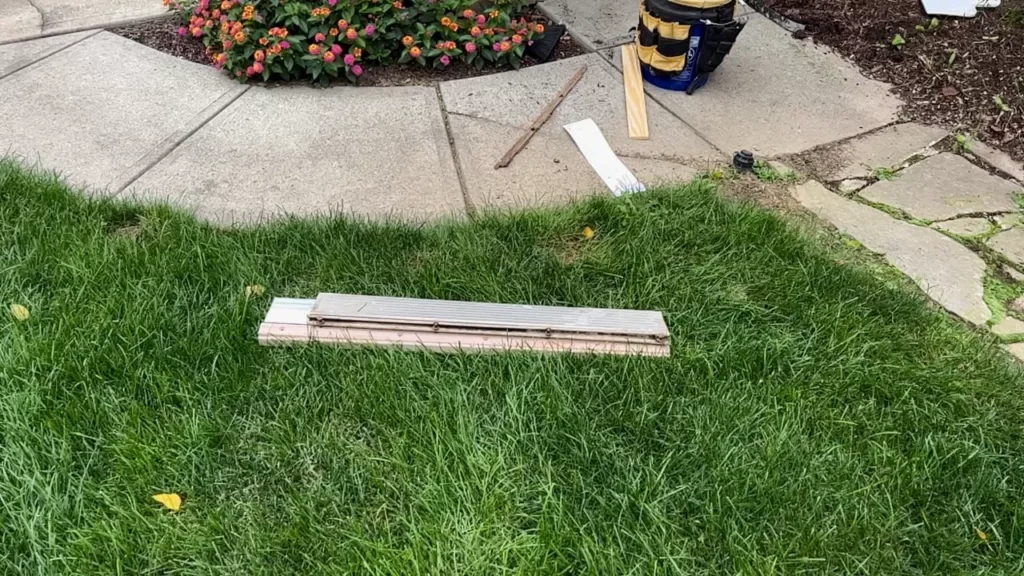
Before diving into the materials needed, it’s important to understand the different types of door thresholds available. The type of door threshold you choose will depend on various factors such as the location, purpose, and style of your door. Here are a few common types of door thresholds:
| Type | Description |
|---|---|
| Aluminum | Lightweight and corrosion resistant, suitable for exterior doors |
| Wood | Natural and aesthetically pleasing, ideal for interior doors |
| Vinyl | Durable and moisture-resistant, commonly used in bathrooms and kitchens |
Tools Required for Installation
Now that you’re familiar with the different types of door thresholds, let’s move on to the tools you’ll need for the installation. Having the right tools will make the installation process smoother and more efficient. Here are the essential tools you’ll need:
- Power drill with concrete drill bits
- Screwdriver
- Hammer
- Tape measure
- Pencil or marker
- Hacksaw or miter saw
- Chisel
- Level
- Masonry nails or screws
- Gloves
Safety Equipment to Have on Hand
Prioritizing safety during the installation process is crucial. It is important to have proper safety equipment on hand to protect yourself from any potential hazards. Here’s the safety equipment you should have:
- Safety goggles
- Ear protection
- Dust mask
- Work gloves
- Knee pads or cushion
By having the right materials, tools, and safety equipment, you’ll be well-prepared to install a door threshold on concrete. In the next section, we will provide step-by-step instructions on the installation process, ensuring a seamless and secure fit.
Step-By-Step Guide To Installing A Door Threshold On Concrete
Welcome to our step-by-step guide on how to install a door threshold on concrete. Properly installing a door threshold is essential for providing a seamless transition between different flooring surfaces and ensuring a tight seal against drafts and pests. In this guide, we will cover each stage of the installation process, from preparing the concrete surface to securing the threshold firmly in place. By following these instructions, you’ll be able to complete the installation with ease and enjoy a durable and attractive door threshold for years to come. Let’s get started!
Preparing the concrete surface for installation
Before beginning the installation process, it’s crucial to properly prepare the concrete surface to ensure a solid and long-lasting foundation for the door threshold. Follow these steps to prepare the concrete:
Cleaning the area
Start by thoroughly cleaning the area where the threshold will be installed. Sweep away any debris or dirt, and use a scrub brush or pressure washer to remove any stubborn stains. Allow the concrete surface to dry completely before moving on to the next step.
Assessing the condition of the concrete
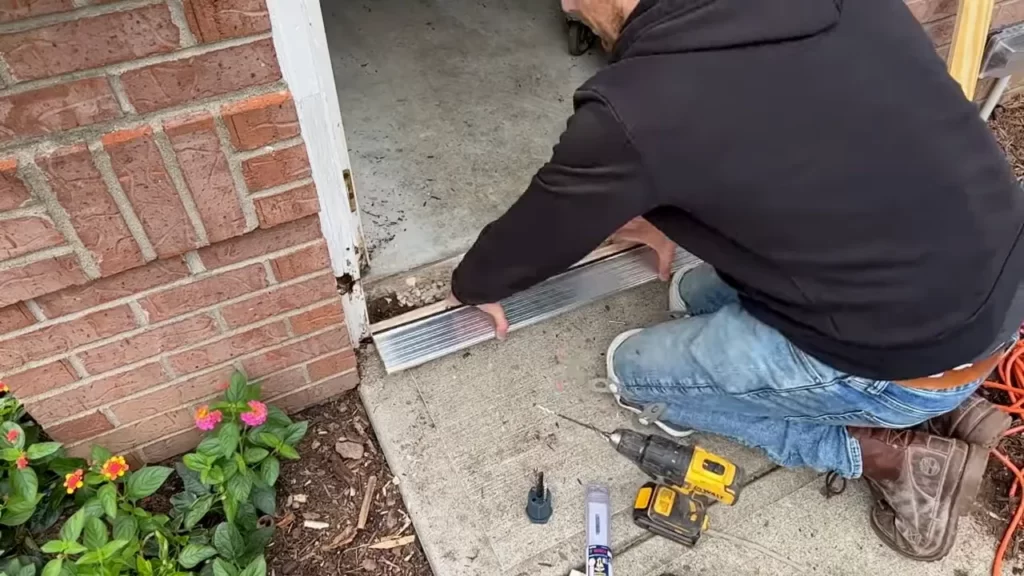
Inspect the concrete surface for any cracks, chips, or uneven areas. It’s important to repair these issues before installing the threshold to ensure a level and secure fit. If you come across any cracks or uneven areas, proceed to the next step.
Repairing any cracks or uneven areas
Fill in any cracks or uneven areas using a concrete repair product. Follow the manufacturer’s instructions for application and allow the product to cure fully before continuing with the installation process.
Choosing the right door threshold
Now it’s time to choose the door threshold that best suits your needs. Consider factors such as the width of your door, the height of the threshold, and your aesthetic preferences. There are various types of thresholds available, each with its own advantages. Let’s explore some of the options:
Understanding the different types of thresholds available
| Type of Threshold | Advantages |
|---|---|
| Capped Threshold | Provides a clean and finished look. Offers protection against moisture and drafts. |
| Saddle Threshold | Perfect for high traffic areas. Provides durability and strength. |
| Interlocking Threshold | Offers a tight seal against water and drafts. Easy to install and replace. |
Selecting a threshold that fits your door and aesthetic preferences
Once you have decided on the type of threshold, it’s important to select one that fits your door and complements your overall aesthetic. Measure the width of your door and choose a threshold that matches or can be trimmed to the required size. Consider the finish and style of the threshold to ensure it aligns with your personal taste and the overall look of your space.
Considering weatherproofing options
If your threshold will be exposed to the elements, it’s essential to consider weatherproofing options. Look for thresholds that come with weatherstripping or seals to provide an extra layer of protection against moisture and drafts. This will help to enhance the energy efficiency of your home and provide a more comfortable living environment.
Measuring and marking the placement
Begin the installation process by measuring and marking the placement of the threshold on the concrete. Use a tape measure and pencil to accurately identify the correct position for installation.
Determining the correct position for the threshold
Consider factors such as the door swing, clearance, and the desired location of the threshold. Ensure there is enough space for the door to open and close smoothly without scraping or hitting the threshold. Take into account any existing flooring materials that will meet the threshold to ensure a seamless transition.
Measuring the width and ensuring a proper fit
Measure the width of the door opening and transfer the measurements onto the threshold. If necessary, use a saw or utility knife to trim the threshold to the correct size. Remember to leave a small amount of room for clearance to allow for slight adjustments during the installation process.
Marking the location for drilling holes
Once you have determined the correct position and size of the threshold, mark the location for drilling holes on the concrete. Use a pencil or marker to clearly identify the spots where the anchors or screws will be inserted.
Drilling holes in the concrete
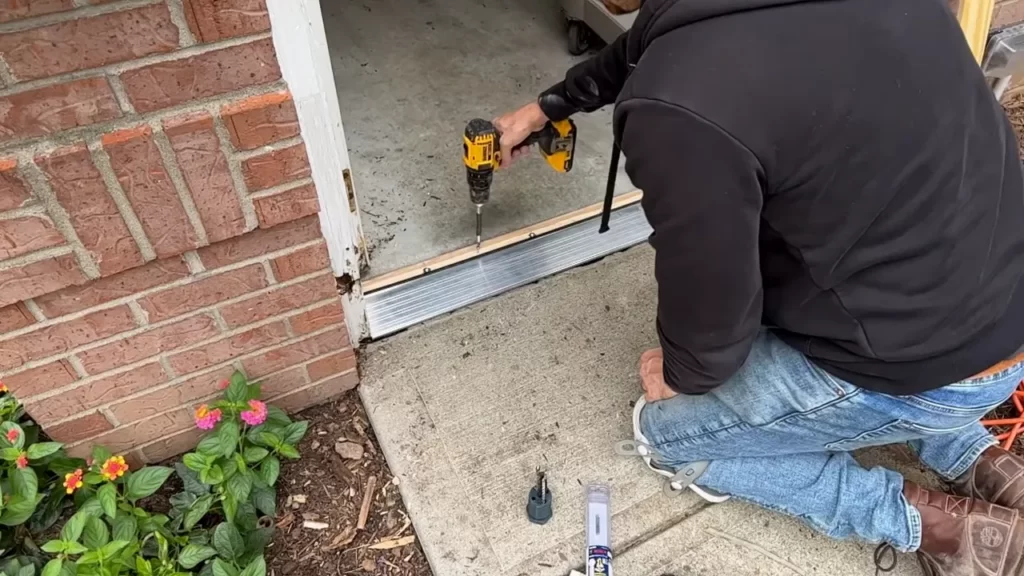
Next, select the appropriate drill bit and drill for the type of anchor or screw you will be using. Refer to the manufacturer’s instructions for the recommended drill bit size and type. Carefully drill holes at the marked locations, ensuring that the holes are deep enough to securely hold the anchors or screws.
Drilling pilot holes for the threshold
Prior to installing the threshold, it’s essential to drill pilot holes in the threshold itself. This will prevent the wood or metal from splitting when the screws or anchors are inserted. Use a drill bit slightly smaller than the diameter of the screws or anchors to create these pilot holes.
Using anchors or screws to secure the threshold to the concrete
Now it’s time to secure the threshold to the concrete using anchors or screws. Insert the anchors into the drilled holes, or drive the screws directly into the holes. Ensure that the anchors or screws fit snugly and securely. Be careful not to overtighten, as this could cause damage to the threshold or the concrete.
Installing the door threshold
With the anchors or screws in place, it’s time to install the door threshold. Follow these steps:
Placing the threshold in position
Carefully place the threshold in position on the concrete, aligning it with the drilled marks. Ensure that the threshold is level and centered properly.
Aligning the holes with the drilled marks
Once the threshold is in place, align the holes in the threshold with the drilled marks on the concrete. Double-check that everything is properly aligned before proceeding.
Tightening the screws or anchors to secure the threshold
Using a screwdriver or drill, tighten the screws or anchors to secure the threshold firmly in place. Check for any movement or looseness, and make any necessary adjustments to ensure a tight and secure fit.
Testing and adjusting the door
Finally, test the door by opening and closing it to ensure proper clearance. Make any adjustments as necessary to ensure smooth operation and a proper seal against drafts and pests.
Checking for a tight and secure fit
Once the installation is complete, inspect the door threshold to ensure a tight and secure fit. Check for any gaps or movement and make any necessary adjustments or tighten any screws or anchors as needed.
Tips And Tricks For Installing A Door Threshold On Concrete
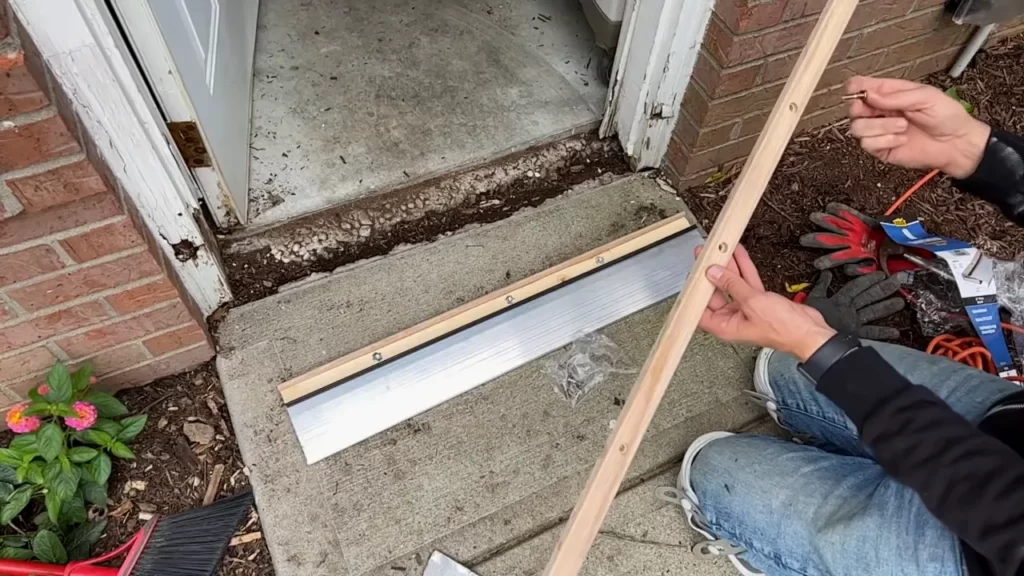
When it comes to installing a door threshold on concrete, there are a few tips and tricks that can make the process go more smoothly. Using a template for accurate measurements, applying adhesive for added stability, and sealing any gaps or spaces between the threshold and the concrete are all important steps to ensure a secure and durable installation. In this article, we will explore these tips and tricks in detail, providing you with everything you need to know to successfully install a door threshold on concrete.
Using a template for accurate measurements
Before you start the installation process, it is essential to have accurate measurements of both the width and height of the doorway. This will ensure that the door threshold fits perfectly and provides a tight seal. One useful tip is to create a template out of cardboard or paper that matches the shape and size of the threshold. By placing the template in the doorway, you can easily make any necessary adjustments before cutting the threshold to size.
Applying adhesive for added stability
Once you have the correct measurements, it’s time to secure the door threshold to the concrete. One of the best methods for this is to use a strong adhesive specifically designed for bonding materials to concrete. Apply the adhesive to the bottom of the threshold and press it firmly into place. Make sure to follow the manufacturer’s instructions for the specific adhesive you are using to ensure proper bonding and stability. Using adhesive will prevent the threshold from shifting or becoming loose over time, ensuring a long-lasting installation.
Sealing any gaps or spaces between the threshold and the concrete
After the threshold is securely attached to the concrete, it’s important to seal any gaps or spaces between the threshold and the concrete surface. This step is crucial to prevent water, dirt, or insects from entering your home. One effective method is to use a waterproof sealant or caulk. Fill in any gaps or spaces with the sealant, ensuring a tight seal. Pay close attention to the edges and corners of the threshold, as these areas are prone to gaps. Allow the sealant to dry completely before using the door to ensure a proper seal.
Installing a door threshold on concrete may seem like a daunting task, but by following these tips and tricks, you can achieve a professional and secure installation. Remember to use a template for accurate measurements, apply adhesive for added stability, and seal any gaps or spaces between the threshold and the concrete. With these steps in mind, you can enjoy a properly installed door threshold that not only enhances the appearance of your doorway but also provides protection against the elements.
Troubleshooting Common Issues In Door Threshold Installation
When installing a door threshold on concrete, there are several common issues that may arise. These issues can impact the overall functionality and aesthetic appeal of the threshold. In this section, we will discuss how to troubleshoot three common problems: threshold not aligning with the door, door sticking or scraping against the threshold, and threshold shifting or coming loose.
Threshold not aligning with the door
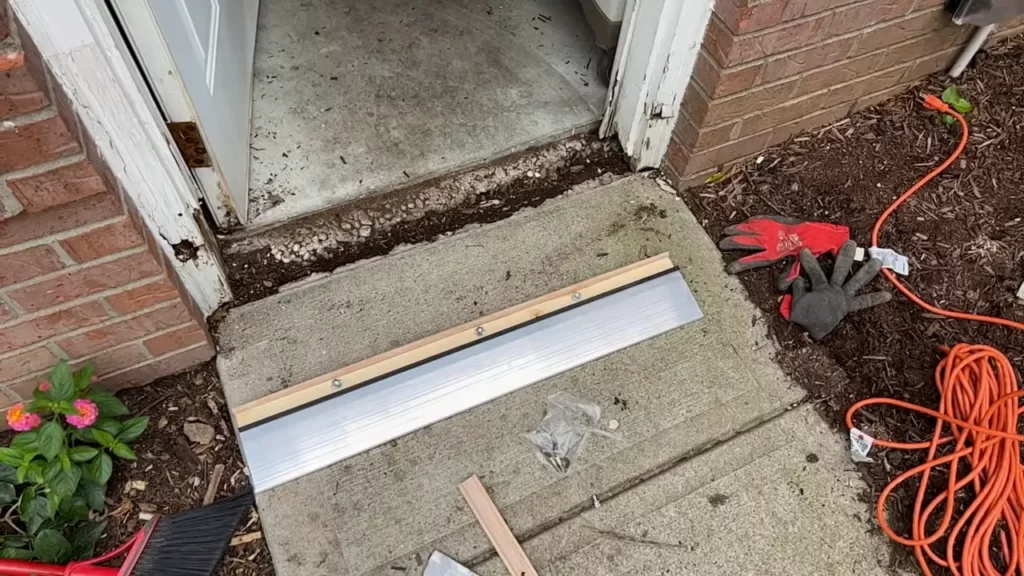
One common issue during door threshold installation is when the threshold does not align properly with the door. This misalignment can create gaps or uneven surfaces, compromising the seal and causing potential drafts. To troubleshoot this issue, follow these steps:
- Check the existing concrete surface for any bumps, ridges, or unevenness that may prevent the threshold from sitting flush. Use a grinder or chisel to remove any obstacles and create a smooth surface.
- Ensure that the threshold is installed at the correct height. Measure the distance between the bottom of the door and the desired height for the threshold. Adjust the threshold’s position accordingly to achieve the proper alignment.
- Secure the threshold in place using appropriate anchoring materials such as screws or nails. Make sure to evenly distribute the fasteners to ensure a secure and level installation.
Door sticking or scraping against the threshold
Another common issue that may occur after installing a door threshold on concrete is when the door sticks or scrapes against the threshold. This can be caused by poor alignment or inadequate clearance between the door and the threshold. To resolve this issue, consider the following troubleshooting steps:
- Check the alignment of the door hinges. Tighten any loose screws and ensure that the door is properly aligned with the hinges to prevent unnecessary friction against the threshold.
- Inspect the threshold for any obstructions such as debris or protrusions that may impede the door’s smooth operation. Clear away any obstructions and ensure a clean, even surface.
- Adjust the height of the threshold if necessary. If the door is consistently scraping against the top of the threshold, consider raising the threshold slightly to provide more clearance.
Threshold shifting or coming loose
Lastly, a common issue with door threshold installation on concrete is when the threshold shifts or comes loose over time. This can cause an unstable and potentially hazardous condition. To troubleshoot and prevent this issue, follow these steps:
- Inspect the existing anchoring materials. Over time, screws or nails may loosen or become damaged. Replace any worn-out or ineffective anchoring materials with new, sturdier ones.
- Consider using adhesive or construction-grade epoxy to reinforce the threshold’s attachment to the concrete. Apply the adhesive according to the manufacturer’s instructions, ensuring a strong bond between the threshold and the concrete surface.
- Regularly inspect and maintain the threshold for signs of shifting or movement. Address any issues promptly to prevent further damage or safety concerns.
By troubleshooting these common issues in door threshold installation, you can ensure a proper, secure, and functional threshold that enhances the overall appearance and functionality of your doorway.
Frequently Asked Questions Of How To Install A Door Threshold On Concrete
How Do You Anchor A Threshold In Concrete?
To anchor a threshold in concrete, follow these steps: 1. First, clean the concrete surface thoroughly. 2. Position the threshold in the desired location and mark the screw hole locations. 3. Drill holes in the concrete using a masonry drill bit.
4. Insert plastic anchors into the holes and tap them lightly to secure. 5. Finally, attach the threshold with screws by aligning the holes.
Can You Glue Down A Threshold On Concrete?
Yes, it is possible to glue down a threshold on concrete.
What Do You Put Under An Exterior Door Threshold?
Under an exterior door threshold, you can put a weatherstripping material or a door sweep. These help to seal the gap between the threshold and the door, preventing drafts, water infiltration, and debris from entering the building.
How Do You Anchor Transition Strips To Concrete?
To anchor transition strips to concrete, follow these steps: 1. Clean the concrete surface thoroughly. 2. Measure and mark the placement of the transition strip. 3. Use a masonry drill bit to make holes in the concrete at the marked spots.
4. Insert plastic anchors into the holes. 5. Secure the transition strip to the anchors using screws.
Q: How Do I Install A Door Threshold On Concrete?
A: Start by cleaning the concrete surface thoroughly. Apply adhesive, then position and press the threshold firmly onto the concrete. Secure it with screws or anchors for added stability.
Q: What Tools Do I Need To Install A Door Threshold On Concrete?
A: You will need a hammer drill or masonry bit, a vacuum cleaner, adhesive, a caulking gun, a screwdriver, screws or anchors, and a level for proper installation.
Conclusion
Installing a door threshold on concrete can be a straightforward process if you follow the right steps. By preparing the surface, measuring accurately, and using the appropriate tools and materials, you can secure the threshold firmly and ensure a proper seal.
Whether it’s for aesthetic purposes or to improve energy efficiency, this simple installation can make a big difference in your home. So, get started and enjoy the benefits of a well-installed door threshold on your concrete floor.
